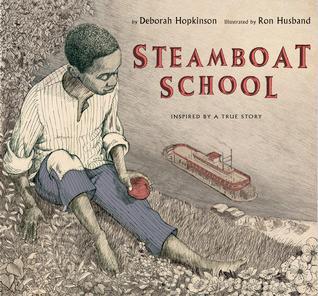
Steamboat School
Read Aloud Book: Steamboat School
Story: Deborah Hopkinson
Illustration: Ron Husband
ISBN-13: 978-1423121961
C3 Framework Key term: Freedom: The lack of coercion or limitation of a person’s thoughts or actions; some definitions include the actual ability of an individual to do what he or she wishes.
Synopsis
James attended a school in the basement of the church. A freed slave, Reverend John Meachum, aspired to teach the children reading, writing, mathematics, and social studies. When Missouri state law forced him to close the school, Reverend John established a new school on the federal water of the Mississippi River.
Discussion
Say: Slaves in the south were not allowed to learn to read and write. They were not allowed access to books, paper, pen, and ink. In some states, the laws extended to free black people. In 1847, The State of Missouri took away the educational rights of freed slaves. The law required that they will not be taught reading and writing, and will not hold assemblies, except in the presence of a sheriff or other public officer. Ask: Why did states take away the right to learn? Say: Literacy was power. People who could read and write could write freedom papers, read about the abolitionist movement, and write to others. They could read the Bible and challenge statements made by white people. Most importantly, educated black people would establish their equal intellectual capacity, hence highlighting the unethical act of slavery. Being able to read the newspaper, enabled slaves to learn about the civil war and reflect on important concepts such as human rights. They used these ideas to confront slaveowners and demand their rights.
Ethics Connection
Say: Today, universal declarations of human rights hold that education is a human right. Everyone, regardless of their race, ethnicity, gender, and religion, should receive an education. However, access to education is a worldwide concern. In some countries, such as Somalia, Niger, Liberia, and Mali, the majority of girls ages 7-16 years from low-income families have never been to school. Ask: How can education help people live a better life? Students may mention, better jobs, healthy life habits, understanding one’s rights, greater access to information and communication, dignity, sense of equality, sense of participation as an equal citizen in informed decision-making, access to technology, and more opportunities for mobility to a new city or country to improve living conditions. Say: In groups, discuss the following ethical dilemma: Henry White owned fifty slaves in 1820. He treated his slaves kindly and wanted them to learn how to read and write. As he was their owner, he considered teaching the slaves in secret. However, if officials caught him, he would pay a large fine and spend time in prison, jeopardizing the health of his household. Henry was torn between his guilt and fear. What should he do?
Fun Activity
Say: The Mis-Education of the Negro by Carter G. Woodson is a well-known, thought-provoking book on education and discrimination. Over the years different book covers were designed, to depict the psychological, economic, and spiritual harm of lack of quality education. These covers show the role that denying education played in oppression. Examine at least three different book covers for this book online. Then, illustrate a new book cover that represents the concepts we discussed today in class.